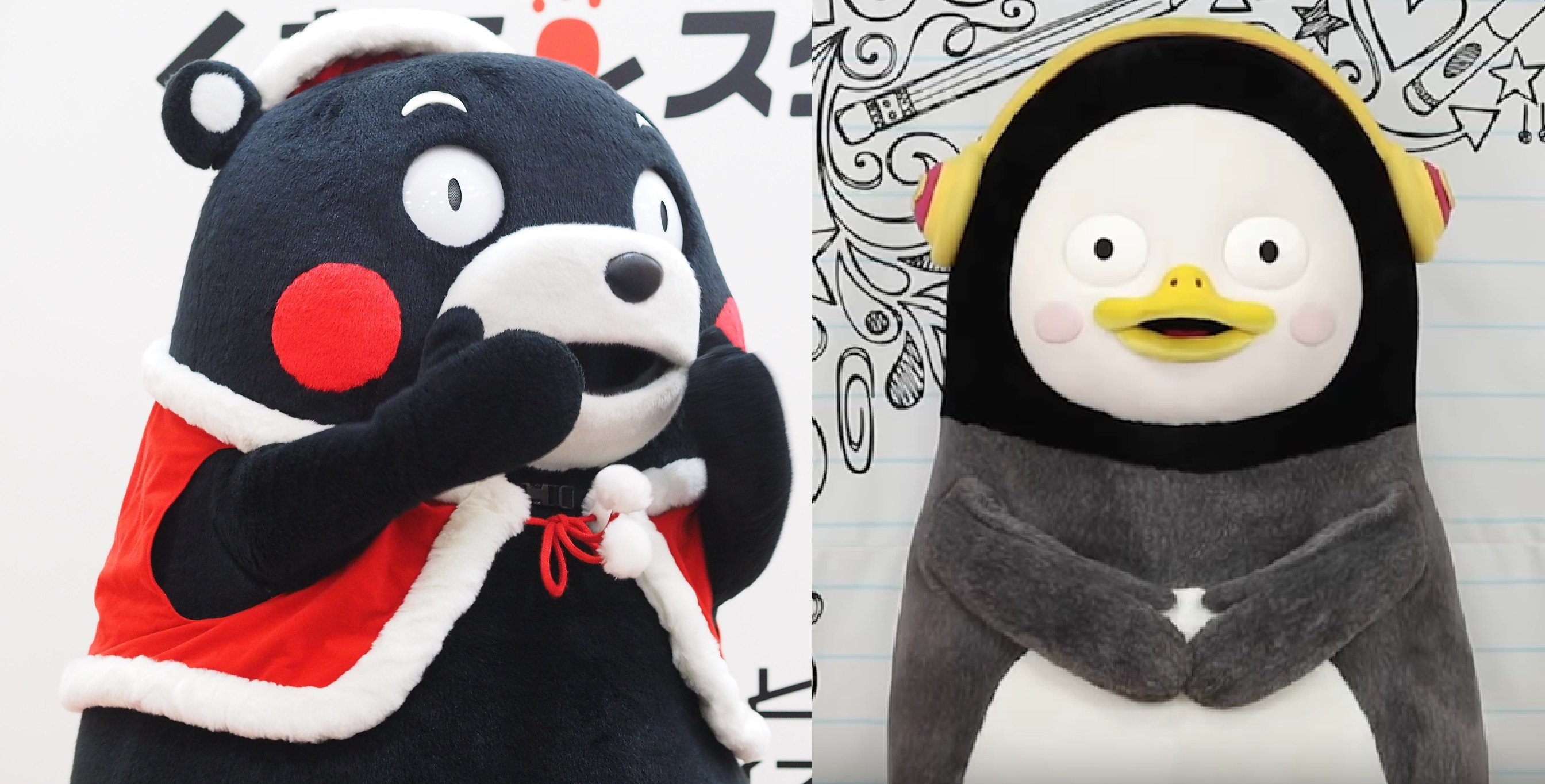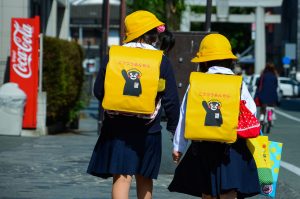In both South Korea and Japan, mascots are ubiquitous and play a key role in marketing, entertainment, and community building for everything from the postal service to provincial city governments to corporations. Most often, those mascots are only recognizable by the community involved in their creation. However, sometimes they gain a life of their own and become immensely popular. When they do, as in the case of Korean penguin Pengsoo and Japanese bear Kumamon, they become indispensable in promotion and financial profit.
This might help explain why a recent feud over the two mascots became public and emotional in the two countries. As the two countries already suffer from a bitter and long-standing historical animosity, this feud can be seen as a puzzle piece of a bigger political and historical picture.
The Pengsoo-Kumamon Dispute
Both Pengsoo and Kumamon are friendly-looking mascots that have gained unexpected levels of fame and popularity in their home countries and abroad.
Pengsoo came to national attention in 2019, when it was created and produced by the Korea Educational Broadcasting System (EBS), the authors of another famous penguin mascot, Pororo. The character came into stardom as an “anti-hero” and a generally relatable character, gaining popularity among children and adults alike. In particular, Pengsoo is appreciated by millennials, who see in the mascot the same struggles they have to face on the ultra-competitive job market. Although mostly unknown abroad, Pengsoo’s popularity in Korea is incredible; the penguin has been used in the media campaigns of Korean conglomerates and even had an opportunity to meet some of the most recognizable K-pop stars and the foreign minister of South Korea.
Kumamon has a longer history. The bear was created in 2010 to promote tourism in Kumamoto prefecture in Japan after the province was connected with a new Shinkansen line. Compared to Pengsoo, Kumamon gained more prominence outside of its home country but has more competition inside Japan and as such never gained total market dominance in its home country. Similar to Pengsoo, Kumamon has been increasingly seen on social media, and it recently opened a YouTube channel.
There was nothing, in particular, tying the two mascots together until recently. The feud started with a piece written on July 9 by a Korean freelance writer for Daily Shincho, a Japanese weekly right-leaning news magazine. It is owned by Shinchosha, a media group famous for scandalous articles catering to the right wing, which might explain the controversial topic. The Daily Shincho reporter implied that Pengsoo and Kumamon are fundamentally alike in the sense that they are both created by government-related agencies for promotional purposes and are animal puppets with big eyes and other similar features. The body of the article was not particularly adversarial, although the reporter implied the possibility of imitation. However, the article was published with a title that provocatively stated Pengsoo is a copycat.
Japanese netizens also started casting doubt on Pengsoo’s originality, and some openly accused Pengsoo of being a “pakuri,” a copycat. One Japanese netizen’s comment on this particular news that received 9,176 likes on Yahoo Japan as of August 15 said: “(Koreans) are ultimately still dependent on Japan despite being openly anti-Japanese. Ironically (Korea) still relies on (Japan) at the end of the day.” Because there was a similar precedent earlier this year, where a cat character released by the Ministry of Food and Drug Safety in South Korea plagiarized the Japanese animated character Doraemon, some Japanese netizens mocked Koreans for disregarding the idea of copyrights laws.
Resentment among Korean netizens ensued. Some argue that “Pengsoo is a penguin, and that makes a difference in the first place.” Some others also retorted that if Pengsoo is a copy of Kumamon, then “Kumamon is a copycat of Mickey Mouse.” Many Koreans saw this as just another attempt by Japanese rightists to unnecessarily provoke a conflict with South Korea. The debate continued, as some Japanese commented that “Koreans who insist on the difference are overly patriotic,” and some others joked that “since [the article] is written by a Korean reporter, it is a fight among the Koreans themselves.”
Although the groups involved in the debate were quite fringe — Korean media acknowledge that most Japanese people do not agree with the “copycat” statement — the conflict nevertheless became heated and gained attention across the media landscapes of both nations.

Kumamon (left, Flickr/othree) and Pengsoo (right, YouTube screenshot)
Unresolved Historical Animosity
The Kumamon-Pengsoo debate is just a microcosm of the unresolved animosity between Japan and South Korea. To better understand the root cause of this feud, a brief overview of the historical problem between Japan and South Korea is necessary.
The current historical debate is the legacy of the Japanese colonization of Korea from 1910 to 1945. Rather than an official acknowledgement and apology for the atrocities perpetrated by Japan, Japanese colonial brutalities in Korea were precipitously buried by both Japanese and South Korean governments in 1965 under the bilateral normalization agreement. That normalization was mostly geared toward economic ends. The 1965 treaty failed to raise many controversial issues, including the concerns of “comfort women,” who were systemically and repeatedly raped at “comfort stations” all over the Asia-Pacific run directly or indirectly by the Japanese military during World War II.
One of the hindrances to the recognition of Japanese war crimes is the social upheaval and political mayhem that South Korea had undergone after World War II, including its forced partition, the Korean War, military dictatorship, and the tumultuous democratization movement that began in the 1980s. Historical problems, including the issue of “comfort women,” were overshadowed by those post-war political disruptions. However, they have resurfaced as one of the focal points of current Japan-South Korea relations since Korea’s first democratically elected president, Roh Tae-woo, was officially inaugurated in 1988.
Bilateral relations have been particularly strained since Moon Jae-in became the president of South Korea in 2017. During this time, South Korean courts ruled that Japanese firms were liable to pay reparations for war-time forced laborers, unleashing the diplomatic tension that continues to have repercussions today. The tit-for-tat between the governments of both countries led to the bottom-up mobilization across South Korea to boycott Japanese products. Popular shops of Japanese brands such as Muji or UNIQLO, once bustling with activity, saw their customer numbers dwindle while restaurants selling Japanese cuisine had to pledge that they only use Korean ingredients and employ Korean staff. Travel to Japan dropped drastically, causing financial hardships in the regions particularly popular to Korean tourists.
The societal pressure was so strong that although not everyone participated in the boycotts, on the surface it looked like everyone did. Those that utilized cheap tickets to travel to Japan abstained from sharing their journeys on social media, while those buying Japanese goods had to do so through online delivery services to avoid being seen in the stores.
A Case of Outrage Culture?
The outrage that we have often observed between Japan and Korea, including the mascot feud, could possibly be a mutually self-fulling prophecy at play. Both countries hold dominantly negative, built-up cultural stereotypes: many Japanese regard Koreans as perpetually angry, radical, and inferior, while many Koreans emphasize the Japanese annexation of Korea and deem Japanese to be unapologetic, apathetic, and arrogant. As a result, bilateral communication – whether diplomatic or on the popular level — tends to be antagonistic, further fueling outrage and conflict, and hindering mutual understanding.
Societal outrage can, however, be an effective unifying force. Bilateral diplomatic and economic tensions between Japan and South Korea, including this mascot debate, serve as a vehicle of mobilizing respective communities. In both countries, national boycotts, street demonstrations, and this online debate over mascots offer political as well as social arenas for both collectives to be reminded of their political identities, deepening the chasm between “us” and “others” while blurring the boundary between “self” and the “state.” The role of outrage is effectively employed in democratic South Korea, which has taken pride in the history of anti-Japanese resistance and, later, emancipation from the military regime that imposed forced historical amnesia, including of Japanese colonial rule. Meanwhile, anger is mobilized particularly among Japanese hatemongers and ultranationalist conservatives, who brandish “rising sun” flags and blast hateful remarks from their loudspeakers, even calling for breaking off diplomatic relations with South Korea.
As bilateral tensions continue to flare, a phenomenon of “Korea fatigue” has permeated Japanese society. The term refers to a pervasive societal exasperation in Japan over what critics of South Korea see as an unrelenting fixation on Japanese colonial rule. In response to the boom of hashtags on twitter in South Korea, such as “#BOYCOTTJAPAN” and “#NOJAPAN”, some Japanese netizens created hashtags like “#韓国疲れ” (Korea fatigue) and“#嫌韓”(dislike Korea).
Although the two countries are at a low point in terms of their relations, and no quick solution is at hand, they are linked by their shared appreciation of each other’s cultures to some extent. Japan experiences the full power of the Hallyu, or the Korean wave, with Korean dramas and music being extremely popular, especially among the younger generations. This a baffling phenomenon for many senior citizens of Japan, who are more inclined to perceive Korea negatively. Alongside the many negative hashtags on Twitter mentioned earlier, many other positive hashtags are trendy too, such “#韓国好き” (like Korea) and “#韓国好きな人と繋がりたい” (want to connect with those who like Korea). On the other hand, when asked, many Koreans appreciate traditional elements of Japanese culture and have a deep admiration for Japanese food and lifestyles. Some Korean young people even grew up watching Japanese anime and listening to J-pop. Perhaps the appeal of soft power, among younger generations in particular, could be an effective agents of mutual understanding and future reconciliation.
The Future?
The mascot feud gained traction not because it is in any way politically or socially significant, but rather because Japanese and Koreans alike often look for new topics to be enraged about to confirm their pre-existing feelings of mistrust and ambivalence. Fundamentally, the conflict about the origins of Pengsoo and its relationship to Kumamon should be treated as an example of the wider historical problems between Japan and South Korea.
Over the past decades, we have seen an increasing resurgence of similar toxic nationalist sentiments and diplomatic stalemates in East Asia. With the prevalence of the internet, online platforms have skewed social perceptions toward the extremes. Although outrage culture can serve as an integrative force among respective national groups, it is not conducive to build a peaceful, forward-looking region. It is important to reexamine the currently confrontational communication style, and formulate a more conciliatory approach on the state as well as non-state levels toward historical animosity, traumas, and memories so that East Asia can eventually flourish and exercise its global political and economic leadership.
Aika Sato is a Yenching Scholar at Peking University, and also a Baixian Scholar at the Baixian Asia Institute. She graduated from Waseda University in Japan and National University of Singapore with dual degrees in International Liberal studies and Political Science respectively.
Marian Fila is a Yenching Scholar at Peking University. Before coming to China, he graduated from King’s College London with a degree in International Development and was a visiting student at Keio, Yonsei, Hong Kong, and Taiwan universities.

































